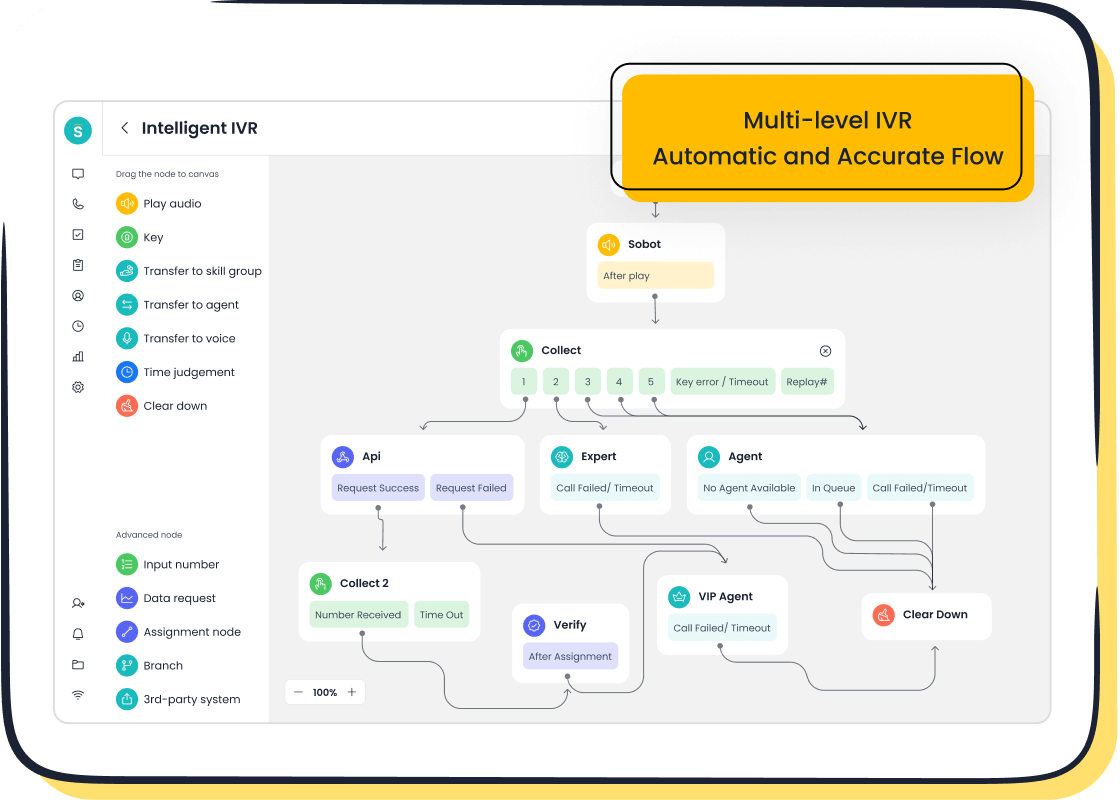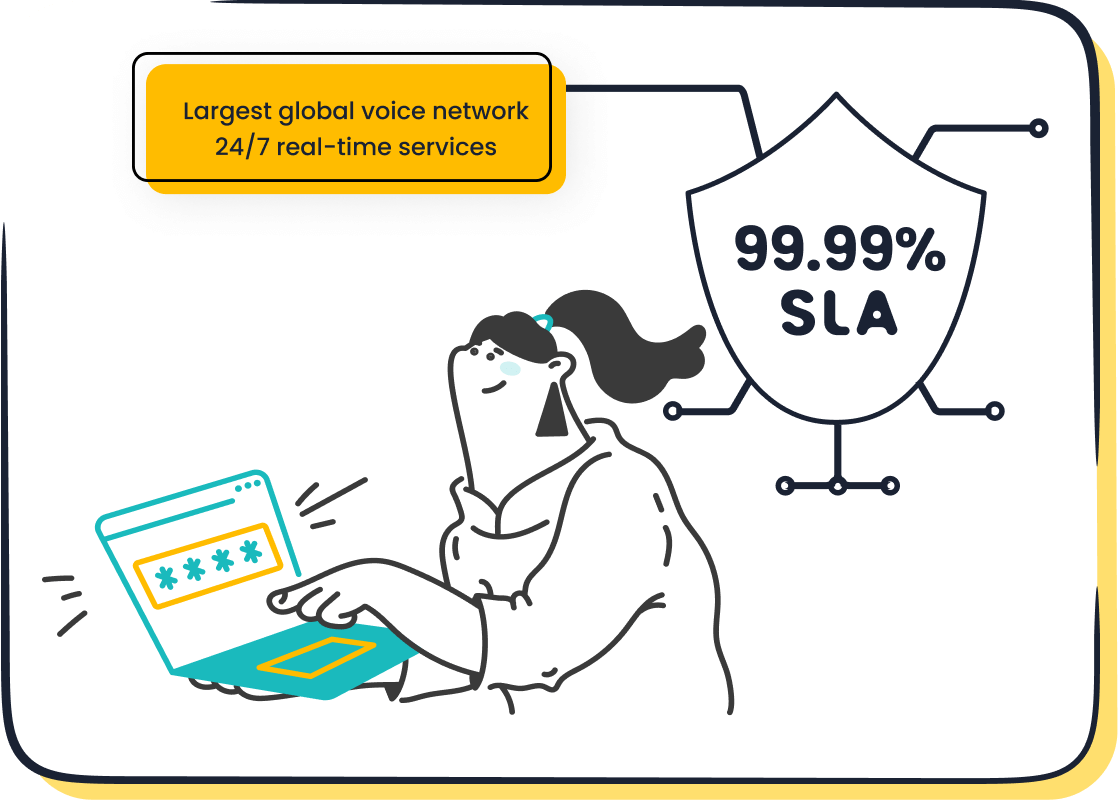The Evolution of the Public Switched Telephone Network

The public switched telephone network (PSTN) has been a cornerstone of global communication for over a century. It enabled seamless voice communication across continents, revolutionizing how people and businesses connect. However, the PSTN switch-off marks a significant shift as analog systems give way to digital networks. This transition impacts various sectors, especially businesses relying on traditional phone lines for critical operations.
The PSTN switch-off will affect a wide range of users, particularly those who rely on traditional phone lines for critical services. Businesses using PSTN or ISDN lines for voice communication, fax machines, or older data transmission methods need to transition to IP-based services.

Organizations must evaluate their infrastructure to ensure compatibility with modern solutions like VoIP. Sobot, a leader in intelligent contact center solutions, offers tools to help businesses adapt seamlessly, ensuring uninterrupted customer service during this transformation.
The Historical Evolution of the Public Switched Telephone Network (PSTN)
The Early Days of PSTN
The invention of the telephone and the birth of telecommunication.
The journey of the Public Switched Telephone Network (PSTN) began in 1876 when Alexander Graham Bell patented the telephone. This groundbreaking invention laid the foundation for modern telecommunication. Shortly after, the first telephone exchange opened in New Haven, Connecticut, in 1878. It connected 21 clients, including the local police and post office, marking the start of a networked communication system.
By the 1920s, rotary dialing and automated exchanges emerged, reducing the need for manual operators. These advancements made call connections faster and more efficient. The introduction of coaxial cables after World War II further enhanced the capacity for long-distance calls, solidifying PSTN as a reliable communication system.
Manual switchboards and the establishment of circuit-switched networks.
In its early days, PSTN relied heavily on manual switchboards. Operators physically connected calls by plugging wires into the appropriate circuits. This labor-intensive process limited the scalability of the network. However, the establishment of circuit-switched networks revolutionized telecommunication. These networks created dedicated pathways for each call, ensuring uninterrupted communication. This innovation became the backbone of PSTN, enabling it to support growing demand.
The Expansion Era
Growth of landline connectivity and global communication.
The expansion of PSTN during the mid-20th century transformed global communication. The introduction of electronic switching systems (ESS) in the 1960s improved call routing and performance. Features like call waiting and conference calls became possible, enhancing user experience. By the 1980s, Integrated Services Digital Network (ISDN) allowed PSTN to handle voice, data, and video over the same lines, making it a versatile platform.
This era also saw the rise of Voice over Internet Protocol (VoIP), which enabled voice communication over the internet. These advancements allowed PSTN to connect families, businesses, and communities worldwide, fostering faster and more efficient communication.
PSTN's role in enabling customer service and business operations.

PSTN played a pivotal role in shaping customer service and business operations. Its reliable infrastructure supported call centers, enabling businesses to interact with customers effectively. For example, companies like Weee! have leveraged modern voice solutions to enhance customer satisfaction. By integrating Sobot's voice product, Weee! improved agent efficiency by 20% and reduced resolution time by 50%. This demonstrates how PSTN and its successors continue to drive innovation in customer service.
The Decline of PSTN and the 'PSTN Switch Off'
Challenges of Analog Technology
Scalability and bandwidth limitations in a digital-first world.
Analog technology struggles to meet the demands of modern communication needs. Its limited scalability and bandwidth make it unsuitable for handling the growing volume of data and voice traffic in today's interconnected world. Unlike digital systems, analog networks cannot efficiently support high-speed data transmission or multimedia applications. Businesses relying on PSTN face challenges in adapting to these limitations, especially as customer expectations for seamless communication continue to rise.
The convergence of analog and digital systems further complicates integration efforts. Analog technologies often lack the efficiency and flexibility required for modern applications, making them less relevant in broader communication contexts. For example, specialized analog systems used in older alarm systems or fax machines require costly upgrades to remain functional in a digital-first environment.
Incompatibility with modern communication needs.

The incompatibility of PSTN with modern communication needs has accelerated its decline. Analog systems cannot support advanced features like video conferencing, real-time data sharing, or AI-powered customer service tools. Businesses transitioning to digital networks gain access to these capabilities, enhancing operational efficiency and customer satisfaction. Sobot’s Voice/Call Center solution exemplifies this shift by offering intelligent IVR, AI-powered voicebots, and seamless integration with CRM systems, enabling businesses to meet evolving communication demands.
Aging Infrastructure and Rising Costs
Maintenance challenges of legacy systems.
The decline of analogue infrastructure has made maintaining PSTN systems increasingly costly and inefficient. Aging equipment requires frequent repairs, and spare parts for legacy systems are becoming scarce. Telecom providers face mounting expenses to keep these systems operational, prompting a shift toward digital alternatives. Residential users and businesses alike must upgrade their telephony equipment to ensure compatibility with modern networks. For businesses, this transition involves interconnected systems like payment terminals and alarm systems, adding complexity to the migration process.
The global shift towards digital alternatives.
The global transition to IP-based networks offers significant advantages over PSTN. Digital communication methods like VoIP provide superior call quality, enhanced features, and cost efficiency. Cloud-based solutions ensure reliability and resilience, while integration with 5G networks enables ultra-low latency and high-speed connectivity. These advancements support innovative applications, such as AI-driven customer service platforms. Sobot’s Voice/Call Center leverages these technologies to deliver scalable and secure communication solutions, helping businesses navigate the PSTN switch-off seamlessly.
Telecom providers are investing heavily in infrastructure upgrades to support this digital-first approach. They offer replacement solutions and support services to ease the transition for users. However, challenges remain, including managing the retirement of legacy systems and ensuring equal access to digital networks across regions.
The Transition to Digital Networks
The Rise of IP-Based Communication
Introduction of VoIP and its advantages for businesses.
The transition to IP-based networks has revolutionized communication, with Voice over Internet Protocol (VoIP) leading the way. Unlike traditional PSTN systems, VoIP uses internet infrastructure to transmit voice data, offering businesses a cost-effective and flexible alternative. Companies adopting VoIP report significant savings, especially for international calls. Advanced features like voicemail-to-email, call forwarding, and video conferencing enhance operational efficiency.
VoIP also integrates seamlessly with other business tools, such as customer relationship management (CRM) systems. This integration improves productivity by centralizing communication and customer data. For example, Sobot’s Voice/Call Center solution leverages VoIP to provide intelligent IVR, AI-powered voicebots, and real-time analytics. These features enable businesses to deliver personalized customer experiences while reducing costs.
| Benefit | Description |
|---|---|
| Cost-Effective | Significantly cheaper, especially for international calls, utilizing internet infrastructure. |
| Advanced Features | Offers capabilities like call forwarding, voicemail-to-email, and video conferencing. |
| Scalability | Easy to scale as businesses grow, unlike PSTN which requires new physical lines. |
| Flexibility | Allows calls from any internet-connected device, unlike PSTN’s reliance on landlines. |
Cost efficiency and scalability for customer service centers.
Customer service centers benefit immensely from VoIP’s scalability and cost efficiency. Unlike PSTN, which requires physical lines for expansion, VoIP allows businesses to add agents or locations effortlessly. This flexibility supports remote work, a critical feature in today’s hybrid work environments. Additionally, VoIP systems reduce setup and maintenance costs, making them ideal for businesses of all sizes.

Sobot’s Voice/Call Center exemplifies these advantages. It offers global number availability, smart call routing, and AI-powered voicebots, ensuring uninterrupted service. These features help businesses scale operations while maintaining high-quality customer interactions.
Integration with Modern Technologies
The role of 5G in enhancing connectivity and reliability.
The integration of 5G technology with IP-based networks has transformed digital communication. 5G offers faster speeds and lower latency, enabling real-time data sharing and seamless communication. This is crucial for remote operations and industries relying on instant responsiveness. For example, 5G’s low latency enhances the performance of IoT devices, allowing businesses to optimize operations.
Organizations leveraging 5G experience improved efficiency and productivity. The technology supports high-speed data transfer, ensuring immediate access to critical information. Sobot’s Voice/Call Center integrates with 5G to provide reliable and scalable communication solutions, helping businesses adapt to the digital transition of PSTN.
Benefits for call centers, including Sobot's Voice/Call Center solutions.
Modern call centers thrive on the integration of advanced technologies like 5G and VoIP. These innovations enhance connectivity, improve sound quality, and support features like AI-driven analytics. Sobot’s Voice/Call Center stands out by offering intelligent IVR, multilingual support, and real-time monitoring. These capabilities streamline operations and improve customer satisfaction.
For example, Weee!, an online supermarket, implemented Sobot’s Voice/Call Center to overcome challenges like language barriers and time zone differences. The result was a 20% increase in agent efficiency and a 50% reduction in resolution time. This demonstrates how modern technologies empower businesses to deliver exceptional customer service.
The Future of PSTN and Communication Technologies
Emerging Trends in Telecommunication
IoT and its impact on smart communication systems.
The Internet of Things (IoT) is revolutionizing communication systems by connecting devices and enabling real-time data exchange. IoT applications, such as smart meters and automotive fleet management, rely on advanced networks to function efficiently. LTE-M, a low-power wide-area network technology, supports these applications by providing deep signal penetration and low latency. This makes it ideal for hard-to-reach locations and large-scale IoT deployments.
For example, LTE-M facilitates intelligent public lighting and environmental monitoring in smart cities. It also enhances healthcare delivery through remote patient monitoring and telemedicine. By enabling real-time health data transmission, LTE-M allows healthcare professionals to provide timely interventions. These advancements demonstrate how IoT and LTE-M are shaping the future of pstn by driving innovation in communication systems.
Adoption of LTE-M for machine-to-machine communication.
Machine-to-machine (M2M) communication is a cornerstone of IoT, and LTE-M plays a critical role in its adoption. This technology supports low data rates and real-time communication, essential for applications like remote equipment control and automation. Industries benefit from LTE-M's reliability and adaptability, which streamline operations and reduce costs.
For instance, LTE-M enables real-time tracking of assets and remote monitoring of medical devices. These capabilities improve efficiency and enhance service delivery across sectors. As businesses transition from pstn to digital networks, LTE-M ensures seamless integration with modern communication technologies.
Cloud-Based Solutions for Businesses
Advantages of cloud telephony for customer support.
Cloud telephony offers numerous advantages for businesses transitioning from pstn. It reduces operational costs while providing advanced features like call forwarding, voicemail-to-email, and video conferencing. These features enhance communication and collaboration within organizations. Integration with CRM systems further improves efficiency by centralizing customer data and interactions.
Cloud-based solutions also ensure minimal service disruptions due to geographic redundancy. Businesses experience low downtime, which is crucial for maintaining customer satisfaction. Sobot’s Voice/Call Center exemplifies these benefits by offering intelligent IVR, automatic call recording, and real-time analytics. These features empower businesses to deliver exceptional customer support while adapting to the future of pstn.
Sobot's role in enabling seamless digital transformation.
Sobot plays a pivotal role in helping businesses navigate the transition to digital networks. Its Voice/Call Center solution integrates advanced technologies like AI-powered voicebots and smart call routing. These features enhance operational efficiency and customer interactions. With a 99.99% system uptime and global number availability, Sobot ensures reliable communication for businesses of all sizes.
Cloud-based solutions are becoming the norm, with over 80% of enterprises expected to migrate by 2025. Companies adopting these strategies report a 19% average revenue increase and up to 30% improved operational efficiency. Sobot’s comprehensive platform supports this shift by providing scalable and secure communication tools. This positions businesses to thrive in the future of pstn and beyond.
Implications for Businesses and Customer Service
Preparing for the Transition
Strategies for migrating from PSTN to digital systems.
Businesses preparing for the pstn switch off must adopt a structured approach to ensure a smooth transition. A needs assessment should be the first step to identify current communication requirements and PSTN-dependent systems. Developing a detailed migration plan minimizes disruptions and ensures all stakeholders are aligned. Staff training is equally critical, as it familiarizes employees with new technologies and workflows. Partnering with telecom experts provides valuable guidance, while a focus on security ensures data integrity during the transition. Strong firewalls and encryption protocols safeguard sensitive information, reducing risks associated with digital migration.
Organizations should also evaluate their existing infrastructure to identify gaps. For example, integrating modern tools like Sobot’s Voice/Call Center can simplify the transition. Its seamless compatibility with CRM systems and AI-powered features ensures businesses maintain operational efficiency while upgrading to digital networks.
Ensuring uninterrupted customer experiences during the transition.
Maintaining uninterrupted customer service during the transition is vital. Businesses must prioritize communication continuity by implementing backup systems and testing new technologies before full deployment. Proactive customer communication about potential changes or downtimes builds trust and reduces frustration. Additionally, leveraging cloud-based solutions like Sobot’s Voice/Call Center ensures high system uptime and global number availability, enabling businesses to provide consistent service. Its intelligent IVR and smart call routing features streamline customer interactions, ensuring minimal disruption during the migration process.
Opportunities in a Post-PSTN World
Leveraging advanced tools like Sobot's Voice/Call Center for customer engagement.

The pstn switch off opens opportunities for businesses to enhance customer engagement through modern communication technologies. Tools like VoIP and cloud-based telephony offer advanced features such as video conferencing, instant messaging, and real-time analytics. These capabilities improve collaboration and streamline workflows. For instance, Sobot’s Voice/Call Center integrates seamlessly with CRM platforms, enabling businesses to centralize customer data and interactions. This integration enhances personalization, leading to improved customer satisfaction and loyalty.
Enhancing efficiency and satisfaction in customer service operations.
Digital networks empower businesses to optimize customer service operations. Features like AI-powered voicebots and smart call routing reduce average handle times and improve first-contact resolution rates. Sobot’s Voice/Call Center exemplifies this efficiency. Its multilingual support and time zone settings allow businesses to serve diverse customer bases effectively. For example, Weee! achieved a 20% increase in agent efficiency and a 50% reduction in resolution time by implementing Sobot’s solutions. These advancements demonstrate how businesses can leverage digital tools to enhance both operational efficiency and customer satisfaction.
The Public Switched Telephone Network (PSTN) has played a vital role in global communication for over a century. Its circuit-switched infrastructure enabled reliable voice communication, connecting people and businesses worldwide. However, the limitations of analog technology and rising maintenance costs have led to its decline. The transition to digital networks offers businesses enhanced scalability, cost efficiency, and access to advanced features like AI-powered tools.
Looking ahead, telecommunication will continue evolving with technologies like 5G and IoT. Companies like Sobot are driving this innovation by providing intelligent solutions such as the Voice/Call Center. These tools empower businesses to deliver exceptional customer experiences while adapting to the demands of a digital-first world.
FAQ
What is the PSTN switch-off, and why is it happening?
The PSTN switch-off refers to the global phase-out of analog telephone networks. Aging infrastructure, high maintenance costs, and the rise of digital networks have made PSTN obsolete. Modern alternatives like VoIP and cloud telephony offer better scalability, cost efficiency, and advanced features for businesses and individuals.
How can businesses prepare for the PSTN switch-off?
Businesses should assess their current systems and identify PSTN-dependent technologies. Transitioning to digital networks like VoIP ensures compatibility with modern communication needs. Tools like Sobot’s Voice/Call Center simplify this process by offering seamless integration, intelligent IVR, and AI-powered voicebots for enhanced customer interactions.
What are the benefits of switching to digital networks?
Digital networks provide superior call quality, scalability, and cost savings. Features like video conferencing, real-time analytics, and smart call routing enhance communication efficiency. Sobot’s Voice/Call Center exemplifies these benefits, enabling businesses to deliver exceptional customer service while reducing operational costs.
Will the PSTN switch-off affect customer service operations?
Yes, businesses relying on PSTN must upgrade to avoid disruptions. Digital solutions like Sobot’s Voice/Call Center ensure uninterrupted service with features like global number availability, multilingual support, and 99.99% system uptime. These tools help businesses maintain high-quality customer interactions during and after the transition.
How does Sobot support businesses during the PSTN switch-off?
Sobot provides advanced communication tools like the Voice/Call Center, which integrates seamlessly with CRM systems. Its features include AI-powered voicebots, intelligent IVR, and real-time monitoring. These solutions help businesses adapt to digital networks while improving efficiency and customer satisfaction.
See Also
Best VoIP Solutions to Explore in 2024
10 Essential VoIP Tools for Small Business Success
Key Features of Interactive Voice Response Software